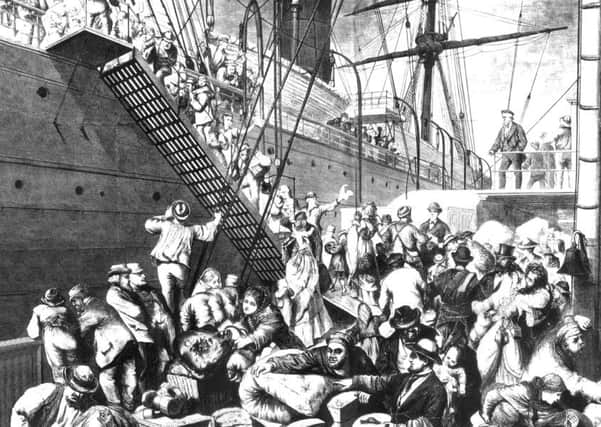The 200 Scots buried in a mass grave in Quebec


But they were never to make it to their final destination after tragedy struck “within an arrow’s flight” of their new adopted homeland.
A total of 264 passengers were killed when a huge fire - “frightful beyond description” - ripped through the paddle steamer, the Montreal, which was to take them south on the St Lawrence River from Quebec.
Advertisement
Hide AdAdvertisement
Hide AdJust nine miles into the journey, a fire broke out in the boiler room and quickly swept through the vessel, destroying it in less than an hour.
Reports suggest that 56 passengers were rescued by a passing steamer, the Napoleon, but the majority of Scots perished in the fire or after hitting the water.
Most of those who died lie in a mass grave in Mount Hermon cemetery in Quebec City, around a mile from the banks of the St Lawrence.
“Here are grandfathers and grandmothers, sons and daughters, husbands and wives, brothers and sisters, and little children, who all perished in the burning of the steam-ship Montreal, bound from Glasgow to Montreal, in June, 1857,” a record of the day said.
Charles Mackay in “Life and liberty in America or Sketches of a tour of US and Canada”, published in 1859, describes the shockwaves created by the disaster.
Mackay wrote: “The sad calamity excited a painful sensation throughout Canada, as well as in Scotland, from which nearly all the emigrants came.
“They were all of the best class of farmers and mechanics, mostly strong young men, with their wives and families, who had saved a little capital by prudence and thrift in the Old Country, and came hither in all the pride of health and strength, and in the flush of hope and enterprise, to try their fortune on a new soil.”
Advertisement
Hide AdAdvertisement
Hide AdThe passengers had first boarded the ship John Mckenzie at Greenock on May 18, 1857, with 332 emigrants on board.
Records show two passengers had died at sea; 69 left Quebec by train; 2 remained in Quebec and 250 chose to board the ill-fated Montreal.
The Montreal had suffered two previous fires in the boiler enclosure that season, but the paddle steamer was deemed fit to sail.
It left Quebec about 4pm on June 26 and caught fire around nine miles down river.
“The wildest panic prevailed,” according to another account, in the Canadian News and British American Intelligencer, on July 6.
It added: “The frenzied and panic-stricken people flung themselves into the water pell mell, flying from the peril of the fire to meet the equally great peril of the water, and perished in it by scores.”
The report detailed the most “intense anxiety” as thousands of anxious spectators crowded the wharfs waiting for the Napoleon and the rescued passengers. There were 58 of them in total. A further 16 dead bodies were laid side-by-side on its deck.
Advertisement
Hide AdAdvertisement
Hide AdThe report added: “What a scene on that clam river, on that bright summer evening! After the long and tedious voyage, just as they were congratulating themselves on their troubles and dangers being over, and were enjoying the brilliant scenery and ever-varying panorama of the St. Lawrence; pleased, gazing on its shores, clothed in all their summer glories, so near, yet alas how far too distant for many; whilst the grand river was sweeping by, so placid yet so treacherous, and so soon to be the resting-place of many.”
The report said it was “impossible to describe all the painful feelings this event has produced.”
Those on board included a Mrs Bloomfield, a mother of four, from Edinburgh who had been due to join her husband in Toronto who was working with the Grand Trunk railway.
During the fire, she lost two of her children, aged 11 and five, and saved the two others, aged one and nine.
It is said she clung to a rope, holding one child in her arms and the other in her teeth.
“She is a slight delicate-looking woman, but yet endured for the occasion, by her maternal instincts, with a giant’s strength,” the report added.
The loss to Canada was considered great given the skills of the emigrants on board and their combined capital.
Advertisement
Hide AdAdvertisement
Hide AdThe Canadian News and British American Intelligencer also reported the great support offered to survivors. Money was sent from Scotland and large sums were raised in Quebec, Montreal, Toronto, and Hamilton.
The Saint Andrew’s Society and the St. Andrew’s Home, which had recently been established to support emigrants, opened their doors. Orphans were placed with “respectable citizens”.
The report added: “Grievous, therefore, as has been the loss of these poor people, and sad as has been their mishap, they do not find themselves amongst unsympathising strangers, but are amongst friends and country people who feel deeply and warmly for their misfortunes, and attest the depth of that feeling by acts and deeds that speak stronger than words.”
It is known, however, that many Scots survivors left Canada as soon as possible.
“Few of the survivors of the calamity remained in Canada. There seemed to their minds to be a curse upon the country, and they returned to the old land in despair,” Mackay said.